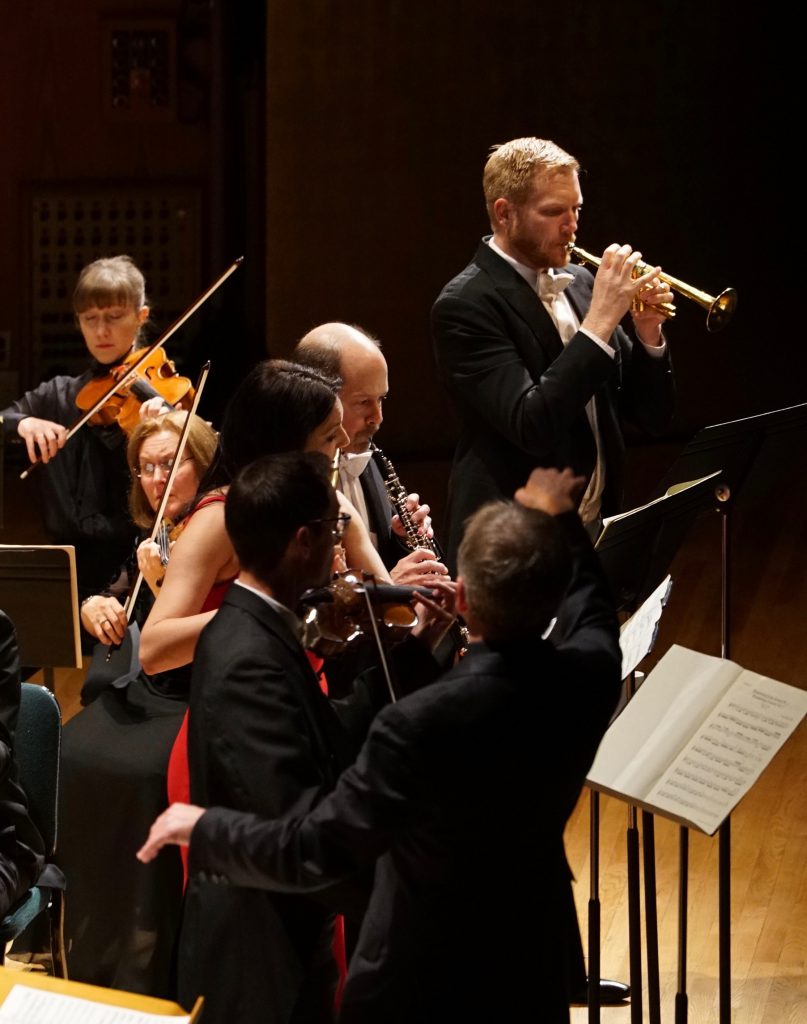Utah Symphony segues from small-scale Bach and Boulez to epic Copland

Utah Symphony members, conducted by Thierry Fischer, performed as soloists in Bach’s Brandenburg Concerto No. 2 Friday night at Abravanel Hall. Photo: Kathleen Sykes
Among 20th-century American composers, Aaron Copland is among the best known and most popular, thanks to the iconic ballets he wrote in the late 1930s and early 1940s.
But Copland also wrote a large body of symphonic works that aren’t played as often—except perhaps for his Third Symphony, which the Utah Symphony performed Fioday night at Abravanel Hall.
The Third is a huge, expansive four-movement work with all the elements that distinguish Copland’s music: sweeping melodic lines, bold themes and a large harmonic palette. There is also an unmistakeable folksy feel to it, something that Copland uses so well to his advantage in many of his pieces.
However, for the most part, the Third is a rather repetitive, loud, brash and banal work that lacks originality. It’s as if he threw together the best of his ballets in writing the symphony.
What does make the Third interesting is Copland’s incorporation of his Fanfare for the Common Man in the finale, which he develops and transforms throughout the movement—an effective way to end this 45-minute symphony.
Conductor Thierry Fischer gave a powerful reading of the work Friday, occasionally letting the brass and percussion sections get out of hand and overpowering the rest of the orchestra. But he did create a finely crafted interpretation with broad strokes and grand gestures that captured the vastness of the music
The orchestra, including a number of local freelance musicians to expand its size, all of whom played wonderfully. Fischer coaxed vibrant, energetic playing from each section, and the strings especially were in top form. It was without question a dynamic and dramatic performance that got the audience to its feet after the final brassy chords.
The first half of the program stood in stark contrast to the epic Copland symphony. The concert opened with the first two of J.S. Bach’s Brandenburg Concertos, which bookended Pierre Boulez’s short Dérive 1, with all three being played with only a brief pause in between each.
At first glance, it might seem rather incongruous pairing Bach and Boulez, but in reality the juxtaposition worked quite well. Both composers make effective use of their instrumental forces, although Boulez’s focus is much more on instrumental timbres rather than specific notation.
At just seven minutes, Dérive 1 is almost Webernesque in its concision, yet Boulez crams a lot into the short span. Scored for six players (violin, cello, flute, clarinet, percussion and piano), the group gave a singularly intense and perceptive account that captured the sound world of the piece wonderfully.
The small ensembles for the two Brandenburgs played with crisp, clear articulation, nicely delineated expressions and clean lines that allowed each part to be distinctly heard.
The solo players (hornists Edmund Rollett and Llewellyn Humphreys in No. 1; flutist Mercedes Smith, oboist James Hall, violinist Claude Halter and trumpeter Travis Peterson in No. 2) played with definition and remarkable self assurance—particularly Peterson, on piccolo trumpet, who navigated his demanding part exceptionally well.
For these three pieces, Fischer divided the musicians onstage into three sections, one for each work, with the spotlight focused on the group that was playing, with the rest of the ensemble in the dark. The setup was unusual but as successful visually as the performance was musically.
The program will be repeated 7:30 p.m. Saturday in Abravanel Hall. 801-355-2787. utahsymphony.org.